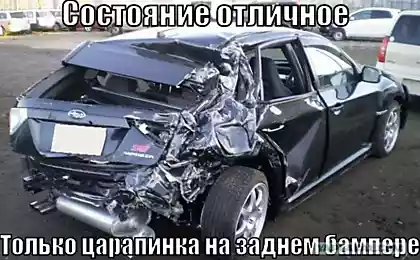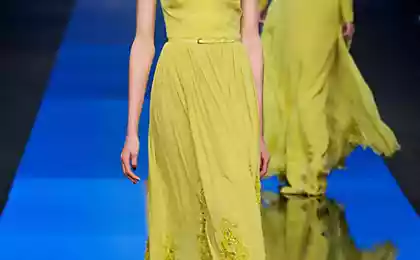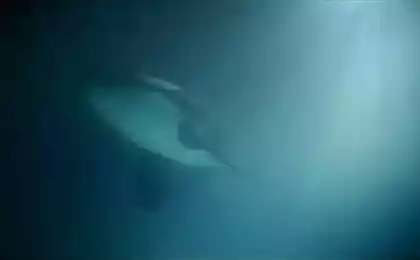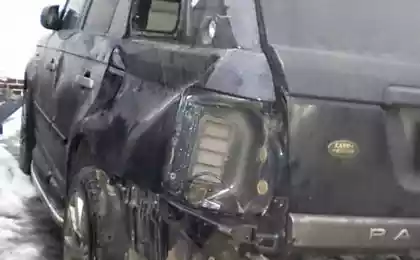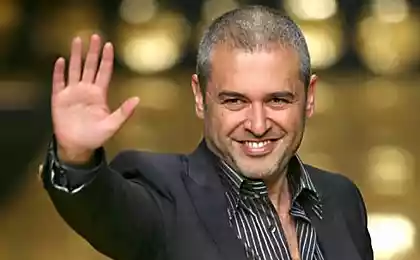925
Saab!
The company Svenska Aeroplan Aktiebolaget - Swedish Airplane Company (SAAB) was founded in 1937. The main objective of the company was the production of bombers and fighters for the air forces of Sweden. The relatively young company today is one of the largest manufacturers of jet aircraft in Europe.
All their achievements in aviation construction Saab is trying to use in the production of cars.
After the war it was decided to re-orient production to build cars. The unique experience of aircraft construction, as well as qualified experts should help in this. To work on the creation of the first prototype of the car were involved 50 aircraft engineers led by Gunnar Langstroma.
Using its own experience and the development of aviation, which were not related conventions and traditions, common in the automotive industry, experts Saab managed to create a prototype, not like the other cars. The newly vehicle shaped like an airplane wing, had front-wheel drive, two-stroke engine transversely located and exceptionally strong frame of the passenger compartment. Created by the efforts of aircraft manufacturers concept is distinguished not only prompt a view, but excellent aerodynamics. Blowing in the wind tunnel body gave a fantastic result Cx = 0, 33. The prototype was named 92001.

The final design of the car was due to the efforts of the company stylist Sixten Sason. The first production car was released in December 1949 and received an index of 92 (index of the last aircraft was 91). Produced Saab 92 up to 1956, but only for this time was made more than 20 000 cars.
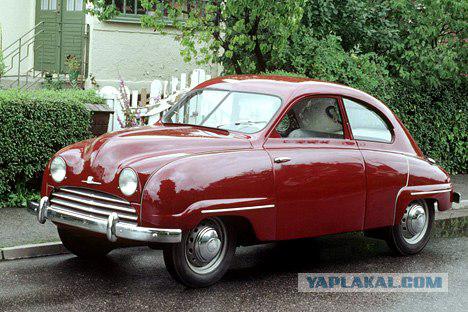
In 1955, Saab has updated its model range and presented a model 93. The new car had radically improved three-cylinder engine, new transmission and tubeless tires. Saab 93 stayed on the line until 1960.
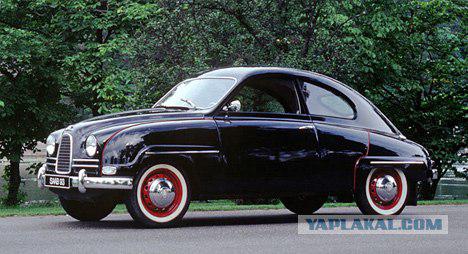
Trying to build a sports model of the company it was made in 1956. Saab Sonett developed capacity of 57, 5 hp, a top speed of 160 km / h and weighed 500 kg. In 1956 he was released just 6 pieces Saab Sonett.
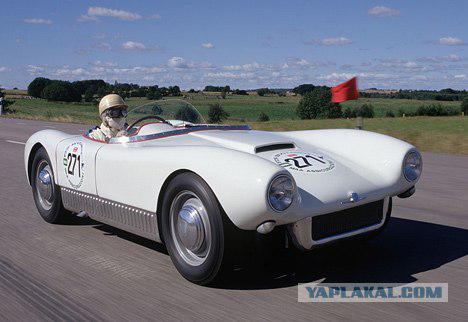
Saab does not leave the idea of serial production of sports car. In 1958 Saab 93 750 Gran Turismo becomes the first production sports car company. Essentially, it was significantly reworked model 93.

A young and dynamic company is trying to cover a large consumer audience and in 1959 released the model 95 - the first cargo-passenger Saab. Saab 95 was equipped with seats for two, five or seven passengers and has a new 4-cylinder V-engine of the German branch of Ford Motor Co.

1960 saw the release of the legendary Saab model 96, which for 20 years has been a leader in the field of sales. Saab 96 was also equipped with a motor Ford Motor Co. Short V-shaped "quartet" successfully entered into the limited space of the hood, however, the nose of the machine still had a slightly lengthened. By 1980, it was released more than 547 000 copies of this model.

Victory in motorsport gave impetus to the creation of two-seater sports car - Saab Sonett II (Saab 97). The development of this model was entrusted to companies MFI from Malmo and ASJ from Harlow. The vehicle body has been manufactured from plastic, reinforced with fiberglass, and had a targa roof type. Debut Saab Sonett II was held in the spring of 1966 at the motor show in Geneva and New York, and by the end of the year have been sold 60 copies of the model.

New Saab 99 was presented on display November 22, 1967. With the advent of this model, the company was able to enter the market segment belonging to the upper middle-class cars. The machine had a great mechanic: inline 4-cylinder engine, the disc brakes on all wheels, an energy absorbing steering column, rear suspension with traction Panara, 3-point seat belts, head restraints (initially US only). The authoritative British magazine «Car» wrote that Saab 99 - is not only an exemplary solid car (the concept of "business class" did not exist yet), but also the safest in Europe.
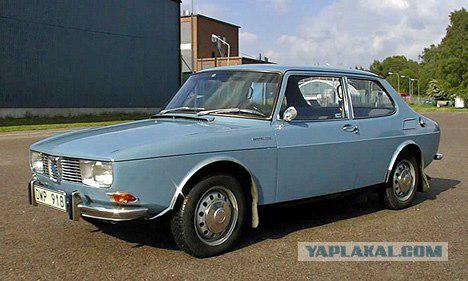
In 1969 Saab AB merged and truck manufacturer SCANIA-VABIS AB. The new company was called Saab-SCANIA AB and had 12 companies in Sweden; headquartered in Södertälje.
The year 1970 was notable for two major events in the history of the company. This year, it rolled off the 500,000th Saab.
There was a Saab Sonett III - seriously modified model Sonett; a new body was designed in the Italian designer Sergio Kodzhiolo. It should also be noted that the Saab Sonett III was the first car company, the shift lever is located on the floor. The most famous sports modification "Swede" was produced through 1974, only 10,219 were collected cars.
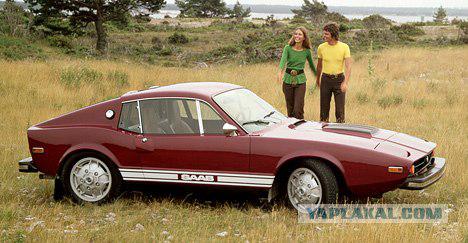
Constant improvement and innovation of the company led to the creation in 1973 of Saab 99 Combi Coupe. The practical hatchback have folding rear seats and a tailgate aperture - it makes the car extremely functional.

With a staff of professionally trained engineers and applying aviation technology, in 1976 the world's first Saab turbocharging uses in serial automobile production. Reliability turbo engine becomes sufficient to use them in production cars. At the auto show in Frankfurt 1977 Saab 99 Turbo produces a sensation. And yet for a long period, Saab remains the sole legislator in the field of turbine construction engines.

Saab 900 II debuted in 1978 in two body styles - 3-door hatchback for its strength and reliability is extremely loved by the police, which is used to spare no official transport, and 5-door hatchback, a very effective due to the additional rear window. Saab did not stop on the way of innovation, and the model with an index of 900 is the first machine in the world with the filter clean the air entering the cabin.

In 1980, the company developed a system of Saab APC, which made it possible to regulate the supply of fuel by increasing or decreasing the pressure of the turbocharger. Lineup 900 is replenished with a new modification of the sedan. In the same year goes to a deserved rest Saab 96.

The first in the history of the automotive industry 16-valve engine with turbocharging - it is a merit of engineers of the company Saab. In 1983 he was born Saab 900 Turbo 16S, equipped with this engine. Saab 900 Turbo 16S is also known as Aero.

An attempt in 1984 to position itself among the business class cars was more than successful. Saab 9000 Turbo firmly secured its position in this segment of the luxury car and has been recognized in America as "the best big car."

In 1984, coming off the assembly line last Saab 99 - his followers proposed a model Saab 90. More is known "Ninety" was not to achieve, because it sold only on the domestic market of Sweden.
With the launch of the 1986 Saab 900 Convertible opened another remarkable chapter in the history of the company.

In 1988, the model range has a new 9000 version of the body - a sedan. The model designation was Saab 9000 CD, equipped with traction control system TCS (Traction Control System).
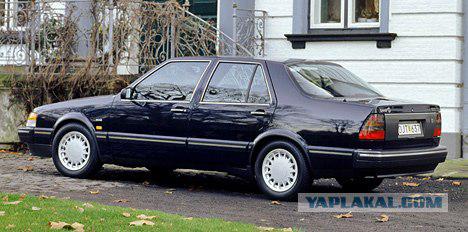
Restructuring department Saab Car in 1990 makes an independent company Saab Automobile AB. AB and General Motors get a 50% stake.
Since 1991 Saab 9000 updates the model, and now it has an index of CS. During restyling Saab 9000 CS receives not only a new look, but also the first in the world equipped with air conditioning, do not use a Fluorinated hladogen, as well as the system of protection against side impacts.

In 1993 saw the first joint project between Saab AB and GM. Saab 900 II (New Generation) had the highest level of security. The car was equipped with a rear seat, the design of which were strained belts, three-diagonal seat belts rear-seat passengers, protection system rear side impact. These innovations have allowed to consolidate the mark Saab fame as one of the safest cars in the world.

Saab 900 Convertible 1994, a new generation of vehicles with folding roof. According to the developers, the new convertible has been made all season. Saab 900 Convertible could be operated year-round, as it was equipped with a double tent, heated rear window and a powerful stove - after all, the northern roots.

In 1997, the flagship Saab 9000 replaced by a new model Saab 9-5. Return to the indexing model in two digits, in the manner of the first cars of the brand, sometimes referred to as a denomination. When you create a model of 9-5 designers and engineers have moved away from the traditional Saab hatchback and four-door sedan introduced. The car had a spacious, luxurious cabin and ventilated seats. In the area of security Saab again introduced a novelty - active headrests SAHR.

In place of the Saab 900 in 1998 came a car with an index of 9-3. Passive safety has become one of the main features of the new 9-3. Also in the 9-3 has been improved suspension and window curtain airbags, consisting of two parts, included as standard. There were changes made in 1100. The difference Saab 9-3 was the fact that it was the first model in the company's history with a turbo-diesel engine.

In 1999, Saab model line expands and presents Saab 9-5 Wagon. Handrails for securing cargo, retractable luggage compartment floor and the roof rack rails provide unlimited opportunities for cargo transportation in this car.

Concept car Saab 9X was introduced in 2001. 9X incorporates features that are inherent in just four types of cars: the coupe, roadster, wagon and pick-up. As the manufacturer, Saab 9X - it's sporty, dynamic, functional car that incorporates all the most attractive they have car brand Saab.

Constant improvements and the search result in the next 9-5 restyling models in 2002. False radiator grille appears genuine, united with the bumper, which gives the car an unusual "Jets" look. Apart from the external appearance of Saab 9-5 M-2002 I received a more powerful engine, improved suspension and a five-speed automatic transmission. There were changes made in 1265.

In 2002, there is a completely new model 9-3. A distinctive feature of the new 9-3 sedan is a car body. The model is called the Saab 9-3 Sport Sedan.

The continuation of a lineup of new generation Saab 9-3 convertible is. In 2003, appears Saab 9-3 Convertible. The new Saab 9-3 Convertible - a truly four-season convertible that combines Scandinavian style and unique innovation capabilities.

In 2005, Saab is another new model of the family hatchback with 9-3 - Saab 9-3 Sport Combi.

The prototype Saab 92001 served as a starting point for further development of the legendary brand. From the day of the solemn display of the first prototype it has been more than half a century, and, Saab has built a strong reputation as an innovator. Engineers who develop the design and construction of cars Saab, again and again surprised the automotive world for its innovative solutions. In most cases a subsequent development are widely used in the automotive industry.
(30th photo!)
While all:

Source:
All their achievements in aviation construction Saab is trying to use in the production of cars.
After the war it was decided to re-orient production to build cars. The unique experience of aircraft construction, as well as qualified experts should help in this. To work on the creation of the first prototype of the car were involved 50 aircraft engineers led by Gunnar Langstroma.
Using its own experience and the development of aviation, which were not related conventions and traditions, common in the automotive industry, experts Saab managed to create a prototype, not like the other cars. The newly vehicle shaped like an airplane wing, had front-wheel drive, two-stroke engine transversely located and exceptionally strong frame of the passenger compartment. Created by the efforts of aircraft manufacturers concept is distinguished not only prompt a view, but excellent aerodynamics. Blowing in the wind tunnel body gave a fantastic result Cx = 0, 33. The prototype was named 92001.

The final design of the car was due to the efforts of the company stylist Sixten Sason. The first production car was released in December 1949 and received an index of 92 (index of the last aircraft was 91). Produced Saab 92 up to 1956, but only for this time was made more than 20 000 cars.

In 1955, Saab has updated its model range and presented a model 93. The new car had radically improved three-cylinder engine, new transmission and tubeless tires. Saab 93 stayed on the line until 1960.

Trying to build a sports model of the company it was made in 1956. Saab Sonett developed capacity of 57, 5 hp, a top speed of 160 km / h and weighed 500 kg. In 1956 he was released just 6 pieces Saab Sonett.

Saab does not leave the idea of serial production of sports car. In 1958 Saab 93 750 Gran Turismo becomes the first production sports car company. Essentially, it was significantly reworked model 93.

A young and dynamic company is trying to cover a large consumer audience and in 1959 released the model 95 - the first cargo-passenger Saab. Saab 95 was equipped with seats for two, five or seven passengers and has a new 4-cylinder V-engine of the German branch of Ford Motor Co.

1960 saw the release of the legendary Saab model 96, which for 20 years has been a leader in the field of sales. Saab 96 was also equipped with a motor Ford Motor Co. Short V-shaped "quartet" successfully entered into the limited space of the hood, however, the nose of the machine still had a slightly lengthened. By 1980, it was released more than 547 000 copies of this model.

Victory in motorsport gave impetus to the creation of two-seater sports car - Saab Sonett II (Saab 97). The development of this model was entrusted to companies MFI from Malmo and ASJ from Harlow. The vehicle body has been manufactured from plastic, reinforced with fiberglass, and had a targa roof type. Debut Saab Sonett II was held in the spring of 1966 at the motor show in Geneva and New York, and by the end of the year have been sold 60 copies of the model.

New Saab 99 was presented on display November 22, 1967. With the advent of this model, the company was able to enter the market segment belonging to the upper middle-class cars. The machine had a great mechanic: inline 4-cylinder engine, the disc brakes on all wheels, an energy absorbing steering column, rear suspension with traction Panara, 3-point seat belts, head restraints (initially US only). The authoritative British magazine «Car» wrote that Saab 99 - is not only an exemplary solid car (the concept of "business class" did not exist yet), but also the safest in Europe.

In 1969 Saab AB merged and truck manufacturer SCANIA-VABIS AB. The new company was called Saab-SCANIA AB and had 12 companies in Sweden; headquartered in Södertälje.
The year 1970 was notable for two major events in the history of the company. This year, it rolled off the 500,000th Saab.
There was a Saab Sonett III - seriously modified model Sonett; a new body was designed in the Italian designer Sergio Kodzhiolo. It should also be noted that the Saab Sonett III was the first car company, the shift lever is located on the floor. The most famous sports modification "Swede" was produced through 1974, only 10,219 were collected cars.

Constant improvement and innovation of the company led to the creation in 1973 of Saab 99 Combi Coupe. The practical hatchback have folding rear seats and a tailgate aperture - it makes the car extremely functional.

With a staff of professionally trained engineers and applying aviation technology, in 1976 the world's first Saab turbocharging uses in serial automobile production. Reliability turbo engine becomes sufficient to use them in production cars. At the auto show in Frankfurt 1977 Saab 99 Turbo produces a sensation. And yet for a long period, Saab remains the sole legislator in the field of turbine construction engines.

Saab 900 II debuted in 1978 in two body styles - 3-door hatchback for its strength and reliability is extremely loved by the police, which is used to spare no official transport, and 5-door hatchback, a very effective due to the additional rear window. Saab did not stop on the way of innovation, and the model with an index of 900 is the first machine in the world with the filter clean the air entering the cabin.

In 1980, the company developed a system of Saab APC, which made it possible to regulate the supply of fuel by increasing or decreasing the pressure of the turbocharger. Lineup 900 is replenished with a new modification of the sedan. In the same year goes to a deserved rest Saab 96.

The first in the history of the automotive industry 16-valve engine with turbocharging - it is a merit of engineers of the company Saab. In 1983 he was born Saab 900 Turbo 16S, equipped with this engine. Saab 900 Turbo 16S is also known as Aero.

An attempt in 1984 to position itself among the business class cars was more than successful. Saab 9000 Turbo firmly secured its position in this segment of the luxury car and has been recognized in America as "the best big car."

In 1984, coming off the assembly line last Saab 99 - his followers proposed a model Saab 90. More is known "Ninety" was not to achieve, because it sold only on the domestic market of Sweden.
With the launch of the 1986 Saab 900 Convertible opened another remarkable chapter in the history of the company.

In 1988, the model range has a new 9000 version of the body - a sedan. The model designation was Saab 9000 CD, equipped with traction control system TCS (Traction Control System).

Restructuring department Saab Car in 1990 makes an independent company Saab Automobile AB. AB and General Motors get a 50% stake.
Since 1991 Saab 9000 updates the model, and now it has an index of CS. During restyling Saab 9000 CS receives not only a new look, but also the first in the world equipped with air conditioning, do not use a Fluorinated hladogen, as well as the system of protection against side impacts.

In 1993 saw the first joint project between Saab AB and GM. Saab 900 II (New Generation) had the highest level of security. The car was equipped with a rear seat, the design of which were strained belts, three-diagonal seat belts rear-seat passengers, protection system rear side impact. These innovations have allowed to consolidate the mark Saab fame as one of the safest cars in the world.

Saab 900 Convertible 1994, a new generation of vehicles with folding roof. According to the developers, the new convertible has been made all season. Saab 900 Convertible could be operated year-round, as it was equipped with a double tent, heated rear window and a powerful stove - after all, the northern roots.

In 1997, the flagship Saab 9000 replaced by a new model Saab 9-5. Return to the indexing model in two digits, in the manner of the first cars of the brand, sometimes referred to as a denomination. When you create a model of 9-5 designers and engineers have moved away from the traditional Saab hatchback and four-door sedan introduced. The car had a spacious, luxurious cabin and ventilated seats. In the area of security Saab again introduced a novelty - active headrests SAHR.

In place of the Saab 900 in 1998 came a car with an index of 9-3. Passive safety has become one of the main features of the new 9-3. Also in the 9-3 has been improved suspension and window curtain airbags, consisting of two parts, included as standard. There were changes made in 1100. The difference Saab 9-3 was the fact that it was the first model in the company's history with a turbo-diesel engine.

In 1999, Saab model line expands and presents Saab 9-5 Wagon. Handrails for securing cargo, retractable luggage compartment floor and the roof rack rails provide unlimited opportunities for cargo transportation in this car.

Concept car Saab 9X was introduced in 2001. 9X incorporates features that are inherent in just four types of cars: the coupe, roadster, wagon and pick-up. As the manufacturer, Saab 9X - it's sporty, dynamic, functional car that incorporates all the most attractive they have car brand Saab.

Constant improvements and the search result in the next 9-5 restyling models in 2002. False radiator grille appears genuine, united with the bumper, which gives the car an unusual "Jets" look. Apart from the external appearance of Saab 9-5 M-2002 I received a more powerful engine, improved suspension and a five-speed automatic transmission. There were changes made in 1265.

In 2002, there is a completely new model 9-3. A distinctive feature of the new 9-3 sedan is a car body. The model is called the Saab 9-3 Sport Sedan.

The continuation of a lineup of new generation Saab 9-3 convertible is. In 2003, appears Saab 9-3 Convertible. The new Saab 9-3 Convertible - a truly four-season convertible that combines Scandinavian style and unique innovation capabilities.

In 2005, Saab is another new model of the family hatchback with 9-3 - Saab 9-3 Sport Combi.

The prototype Saab 92001 served as a starting point for further development of the legendary brand. From the day of the solemn display of the first prototype it has been more than half a century, and, Saab has built a strong reputation as an innovator. Engineers who develop the design and construction of cars Saab, again and again surprised the automotive world for its innovative solutions. In most cases a subsequent development are widely used in the automotive industry.
(30th photo!)
While all:

Source:









